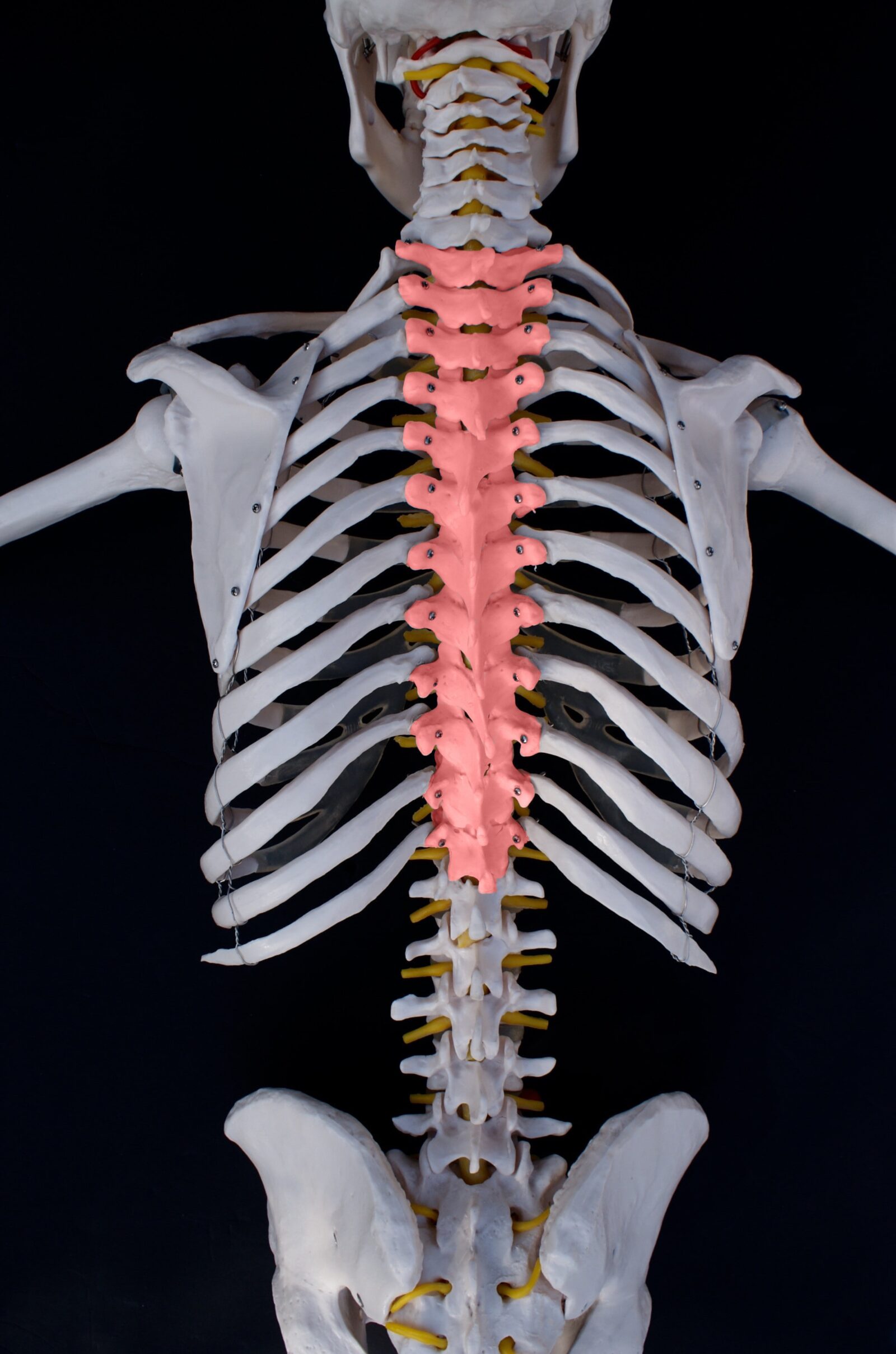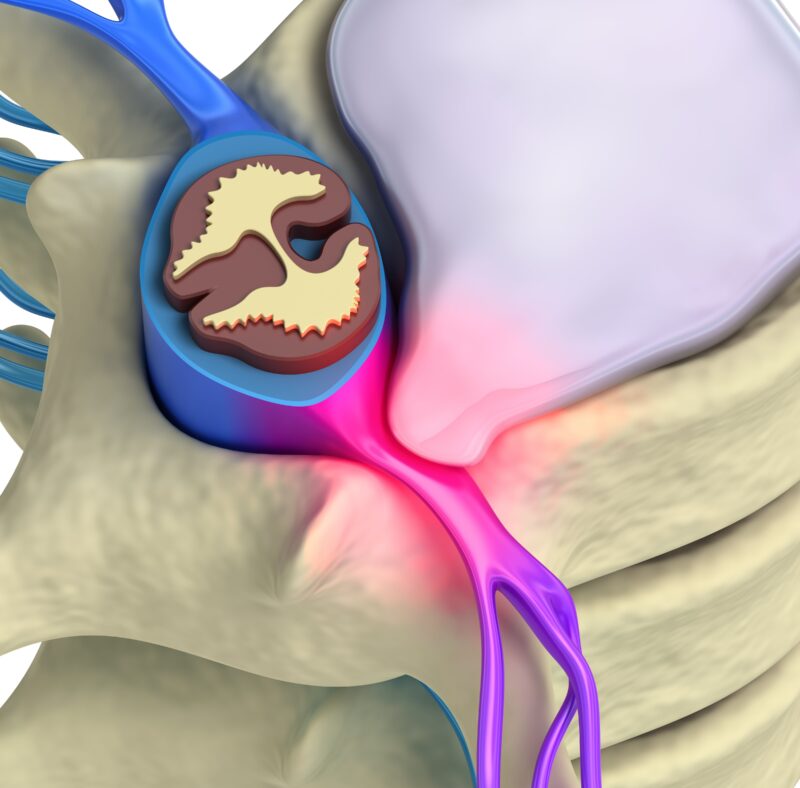Herniated discs are a common condition that can cause significant pain and discomfort in the back. While most people are familiar with herniated discs in the lumbar (lower back) and cervical (neck) regions of the spine, herniated discs can also occur in the thoracic (mid-back) region. In this blog, we will explore the causes, symptoms, diagnosis, treatment, and prevention of thoracic herniated discs.
The Thoracic Spine

The thoracic spine is the region of the spine that extends from the base of the neck to the bottom of the rib cage. It consists of 12 vertebrae, labeled T1 to T12. The thoracic spine is unique compared to other regions of the spine for several reasons.
First, the thoracic spine is attached to the rib cage, which provides stability and protection for the vital organs such as the heart and lungs. The rib cage is also responsible for the expansion and contraction of the chest during breathing.
Second, the vertebrae in the thoracic spine are smaller than the vertebrae in the cervical and lumbar regions. This is because the thoracic spine does not need to support as much weight as the other regions of the spine.
Third, the thoracic spine has a natural curve that helps to distribute the weight of the upper body evenly. This curve is called a kyphotic curve, and it is different from the lordotic curve in the cervical and lumbar regions.
Finally, the thoracic spine has limited mobility compared to the cervical and lumbar regions. This is due to the attachment of the rib cage and the smaller size of the vertebrae.
Herniated Discs
Herniated discs, also known as slipped discs or ruptured discs, occur when the soft inner material of a spinal disc leaks out through a tear or rupture in the outer portion of the disc. Spinal discs are the shock-absorbing cushions that separate the vertebrae in the spine and allow for flexibility and movement. When a disc herniates, the soft material can press on the nerves that run through the spinal column, leading to pain, numbness, or weakness in the affected area. Herniated discs can occur anywhere in the spine, but they most commonly occur in the lumbar (lower back) and cervical (neck) regions. Herniated discs in the thoracic region are relatively rare compared to the lumbar and cervical regions. This is because the thoracic spine is less mobile and subjected to less stress and strain than the other regions.
Causes of Herniated Thoracic Discs
Herniated thoracic discs are relatively rare compared to herniated discs in the lumbar and cervical regions. However, herniated thoracic discs can still occur and are typically caused by the following factors:
- Trauma: A direct blow to the back or a fall can cause a herniated disc in the thoracic region.
- Degenerative changes: Age-related wear and tear can cause the discs in the thoracic spine to become brittle and more prone to herniation.
- Poor posture: Sitting or standing in a slouched or hunched position can put excess pressure on the thoracic discs, leading to herniation over time.
- Repetitive motion: Certain occupations or activities that involve repeated twisting or bending of the back can put the thoracic discs under excessive stress and increase the risk of herniation.
- Genetics: Some people may be more prone to herniated discs due to inherited factors that affect the strength and flexibility of the spinal discs.
It is important to note that herniated thoracic discs are relatively rare and often go undiagnosed or misdiagnosed, as their symptoms can be similar to other conditions. If you are experiencing back pain or other symptoms in the thoracic region, it is important to seek medical attention to determine the underlying cause and receive appropriate treatment.
Symptoms of Thoracic Herniated Discs
Symptoms of a herniated disc in the thoracic spine can vary depending on the location and severity of the herniation, as well as the individual’s age and overall health. Some common symptoms of a thoracic herniated disc may include:
- Pain in the middle or upper back: This is the most common symptom of a herniated disc in the thoracic spine. The pain may be localized to the area around the herniated disc or may radiate to other parts of the body, such as the chest, abdomen, or arms.
- Numbness or tingling: Herniation of a thoracic disc can put pressure on the spinal nerves, leading to numbness or tingling in the affected area.
- Muscle weakness: In severe cases, a herniated disc can compress the nerves that control muscle function, leading to weakness or difficulty moving certain parts of the body.
- Difficulty breathing: A herniated disc in the thoracic spine can put pressure on the lungs or diaphragm, making it difficult to breathe or causing shortness of breath.
- Loss of bladder or bowel control: This is a rare but serious symptom that can occur if a herniated disc in the thoracic spine puts pressure on the nerves that control bladder or bowel function.
If you are experiencing any of these symptoms, it is important to seek medical attention promptly to determine the underlying cause and receive appropriate treatment. Treatment for a herniated disc in the thoracic spine may include rest, physical therapy, pain medication, or in severe cases, surgery.
Diagnosis, Treatment, and Prevention

Diagnosis of thoracic herniated discs typically involves a physical examination and medical history, as well as imaging tests such as an MRI or CT scan. Electromyography (EMG) or nerve conduction studies may also be used to evaluate nerve function.
Treatment for thoracic herniated discs may involve conservative options such as rest, physical therapy, and pain medication. Minimally invasive procedures such as epidural steroid injections may also be used to manage symptoms. Surgery is typically a last resort and is only recommended if conservative treatments fail to provide relief.
Preventing thoracic herniated discs involves practicing good posture and body mechanics, engaging in regular exercise and stretching, maintaining a healthy weight, and avoiding repetitive motions or heavy lifting.
In Conclusion
In conclusion, thoracic herniated discs can cause significant pain and discomfort, but with proper diagnosis and treatment, most people are able to manage their symptoms and enjoy a good quality of life. If you are experiencing symptoms of a herniated disc, it is important to seek medical attention to determine the underlying cause and develop an appropriate treatment plan. By taking steps to prevent thoracic herniated discs, you can reduce your risk of developing this condition and maintain a healthy spine for years to come.










